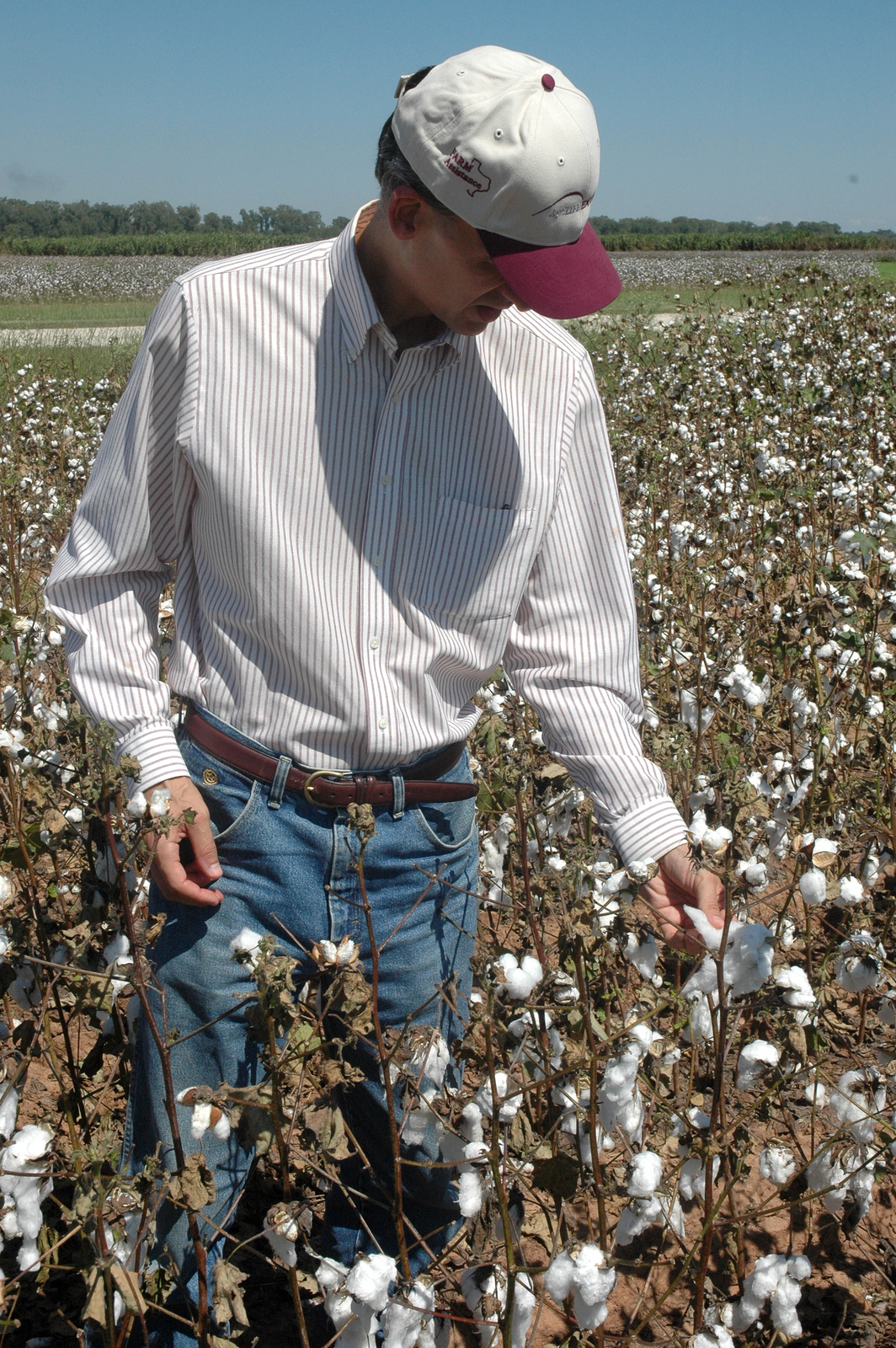|
Texas AgriLife Extension cotton economist shares observations on China trip
College Station, Texas, USA
January 16, 2013
Texas A&M AgriLife Extension Service cotton economist John Robinson recently toured what he calls “the West Texas of China,” trekking to southern Xinjiang to get a first-hand look at farming and harvesting practices.
The result of his two-week trip abroad was a collection of observations — views of farming practices and other insights — that will serve as aids in forecasting cotton trends for Texas and U.S. farmers, plus help determine potential worldwide demand.

Dr. John Robinson, Texas A&M AgriLife Extension Service cotton marketing economist, inspects cotton at field trials near College Station. Robinson recently toured what he calls “the West Texas of China,” trekking to southern Xinjiang to get a first-hand look at farming and harvesting practices. (Texas A&M AgriLife Extension Service photo by Blair Fannin)
“Cotton is obviously king there,” he said. “They’re trying to diversify the region’s agriculture by growing more ‘jujubee’ orchards — sort of like a date, potatoes and other (crops).”
He said there is little transportation system in place, observing carts that are typically used for onions and other commodities being hauled.
“If I had to guess I’d say that Xinjiang is probably like West Texas in that it will be the last bastion of domestic Chinese cotton production,” he said “They have to overcome problems with saline soils, and lack of labor, and the cost of hauling cotton bales from there to the eastern portion of China. One way they’re dealing with the latter is trying to establish more cotton spinning and cloth/apparel (towels) manufactured locally in Xinjiang.”
In Xinjiang, it is “incredibly dry and is much like West Texas,” Robinson said.
“Everything is irrigated, and the irrigation system appears to be a system of canals tapping into reservoirs of snow-melt water from the nearby mountains,” he said. “I saw a few instances of visible white salt on the soil surface; it was obvious they have a soil salinity problem.”
Most of the fields he viewed had been harvested, mostly by hand.
“The fields themselves look like nice 10 to 20 acre rectangles, bordered by a row of trees,” he said. “I think the purpose of the border is like a Rolling Plains shelter belt to mitigate sandstorm damage. They harvest seed cotton and dump it at the edge of the field in a pile. I guess that works as long as it doesn’t rain… I don’t get the impression that it rains very much.”
Robinson said at some point, a tractor pulling a trailer showed up and the seed cotton is thrown in and hauled to a gin.
“In terms of marketing, that’s where the growers sell their cotton to the gin-buyer,” Robinson said. “I think that’s the same model just about everywhere else (except the U.S., Brazil, and Australia where growers retain ownership of ginned bales).”
Robinson said when the group visited a gin on a Saturday, it looked like a normal gin operation on the inside.
“There were piles of seed cotton outside, covered with tarps,” he said. “From what I saw of the hand- harvested cotton, it was pretty clean looking. I’ve heard things about hand-harvested cotton in Africa and India where there is lots of human hair contaminant, plus rocks, etc. But this stuff looked pretty clean to my uneducated eye. This gin had one line that was ginning hand-harvested cotton. It had a separate line that was ginning machine-picked cotton.”
Robinson said the finished pressed bale was wrapped in the normal looking ties and then a plastic wrap. The finished bales were stored outside in big stacks. Some of the stacks had huge tarps over them and some did not.
“I was told these bales were heading north, presumably to some warehouse owned by the quasi-military, quasi-government agency which everybody just calls the Corps. This is the historical legacy of this place. There were a bunch of Chinese military out there and when they were retired from military service, they got retrofitted into cotton farmers.”
He also toured a custom harvest business run by a father-and-son team.
“They had quite a collection of equipment, which they admitted was financed in part from the Chinese government, some sort of borrowing subsidy,” he said. “They have 37, six-row Case pickers. These were stored in a huge compound of garage bays that either housed the pickers or housed piles of machine parts, oil, etc. you name it.
“The compound also had fuel tanks and fuel trucks, and quite a number of ‘living boxes,’ which were big trailers that could accommodate a harvest crew. The system is geared for mobility — they haul around the machines, the crews, the fuel, etc. to wherever they’re picking.”
Robinson said, the university faculty there have a favorable view of Texas A&M and he did his best to enhance that view.
“I think their goal generally is to increase the quality of their faculty by exposing them to the U.S., e.g., delegation trips and visiting scholars,” he said.
More news from: Texas A&M AgriLife
Website: http://agrilife.org/ Published: January 16, 2013 |